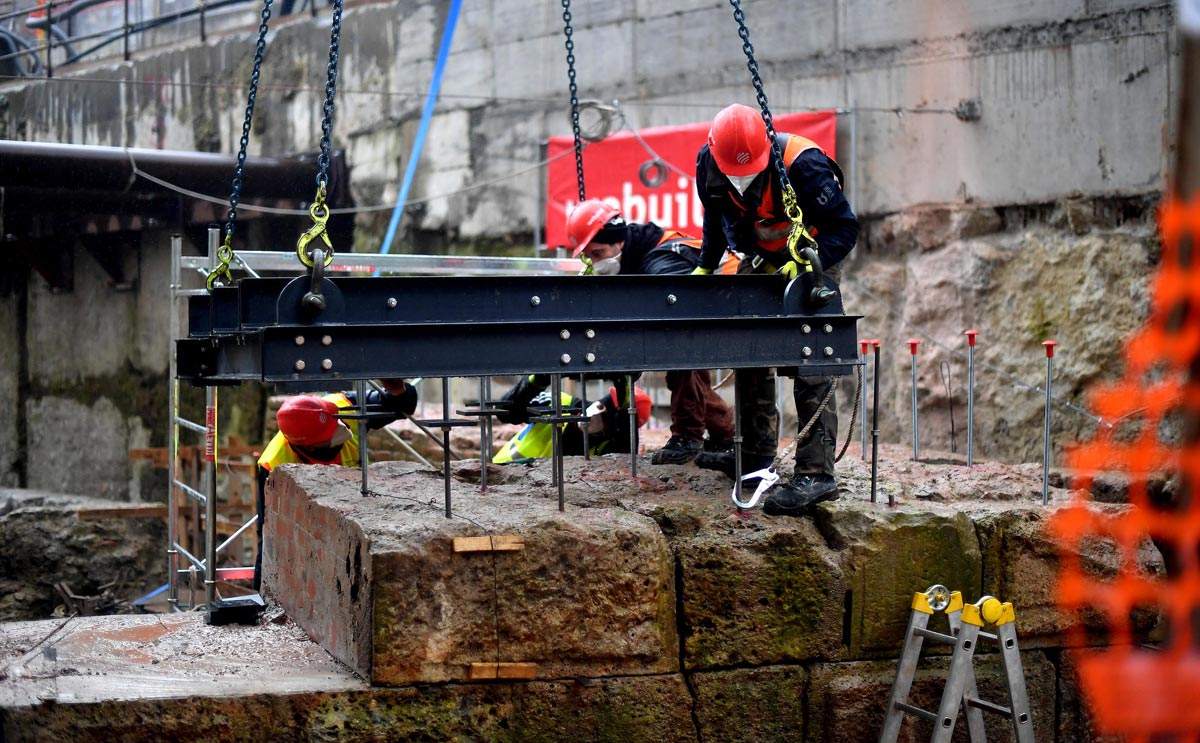Work is underway in Milan to move the archaeological evidence that emerged last March from the excavation of the M4 subway line at the De Amicis station construction site. This is the second major find at the construction site: it is an ancient wall structure, the origin of which is now being studied, as it could be a section of the medieval walls at Pusterla dei Fabbri, or a portion of a hydraulic reticulum from the late ancient or medieval period. Archaeologists, however, rule out the possibility that it could also be the foundation of a tower with defensive functions or related to the presence of water entering Milan. It is a corner structure, and the axis along Via De Amicis likely constitutes the ancient bank of the San Girolamo canal.
To shed more light on the origins of the structure and its functions, on the instructions of the Soprintendenza Archeologia, Belle Arti e Paesaggio of the Metropolitan City of Milan, M4 is editing a monographic publication that, in addition to historical topographical insights, cognitive studies on the material composition and construction technique, by experts in the field, will also recount the various phases of work on site for its disassembly and relocation.
The structure that resurfaced from the subway excavations is imposing and monumental both in terms of its size (it is about 2.5 meters high and the length of its sides is about 10 meters, with thickness greater than 2 meters) and its workmanship. In fact, it is composed of ashlar-worked stone blocks, with the signs of the grooves for the “olivelle,” the presence of functional elements for a water regulation system. These are probably salvaged materials from Roman monuments such as the Theater or Amphitheater.
As mentioned, workers in these hours are at work with cranes to dismantle the wall that resurfaced from the excavation of the De Amicis station, which will therefore be removed from the area where it was found and will be relocated to the area where the Amphitheater stood: the move was decided in agreement with the superintendence to allow the construction of the subway line.
“With these excavations of the M4 subway,” says Antonella Rainaldi, superintendent of Milan, “we have rediscovered an important testimony of medieval Milan in the water system of the water canals, at a nodal point, at the entrance of the Vetra canal in the city that continued into San Lorenzo. But what is unique is the monumentality of this embankment, which is largely made of large stone blocks of Adda stump. These blocks are ancient, reused, from the Amphitheater that was right nearby.”
“The excavations of the M4,” Marco Granelli, Councillor for Mobility and the Environment of the City of Milan, points out, “have allowed us to find walls that were probably made in medieval times with Roman stones: these are important finds. Part of this wall, probably the Naviglio bank wall, will be in the station, part will go into the new Amphitheater Archaeological Park, which will be an important museum route for Milan. So a subway that not only helps us travel better, travel faster and with cleaner air, but also allows us to rediscover elements of our history and make them available to our fellow citizens.”
The area of the Roman Amphitheater is now being redeveloped by the Superintendence for the creation of the future “Pan,” the Amphitheatrum naturae Park, the largest archaeological park in Lombardy, located in the heart of the city, between Via Arena and Via Conca del Naviglio, at Ticinese. In that area, a new large elliptical garden will be created with greenery, among hedges and bushes of boxwood, myrtle, privet and more than a hundred cypresses, tracing the plan of the ancient Amphitheater, reconstructed on the model of the one that existed in Roman times: it is a project of “green archaeology” inspired by the theme of symbiosis between vegetation and archaeological remains.
In the photo, workers during block removal operations.
 |
| Milan, ancient walls found in the excavation of the M4 are being moved to pass the metro |
Warning: the translation into English of the original Italian article was created using automatic tools. We undertake to review all articles, but we do not guarantee the total absence of inaccuracies in the translation due to the program. You can find the original by clicking on the ITA button. If you find any mistake,please contact us.